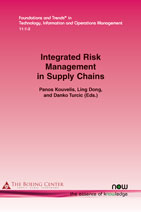Introduction to the Special Issue on Integrated Risk Management in Supply Chains
By Panos Kouvelis, Olin Business School, Washington University in St. Louis, USA, kouvelis@wustl.edu | Ling Dong, Olin Business School, Washington University in St. Louis, USA, dong@wustl.edu | Danko Turcic, Olin Business School, Washington University in St. Louis, USA, turcic@wustl.edu
Abstract
This special issue, which surveys the most recent research in integrated risk management for supply chains, is motivated by the success of the third “Supply Chain Finance & Risk Management Workshop,” which was held at the Olin Business School of Washington University in St. Louis, on May 14-15, 2017. The Editors wanted a more timely access to the latest research on supply chain finance and supply chain risk management. It is well-known, that due to review process lead times, articles published in traditional journals can take 2 to 3 years. The idea of producing an edited volume, which would include the latest articles on the topics above appealed not only to the workshop participants but also to other active members of the iFORM (Interface of Finance, Operations, and Risk Management) research community. Foundations and Trends in Technology, Information and Operations Management provides an ideal outlet for such a volume.
Integrated Risk Management in Supply Chains
Integrated Risk Management in Supply Chains examines supply chain risk management. The increased interest in the topic is due to a number of factors including the increased volatility of commodity prices and exchange rates, recent natural disasters, and the increased importance of multinational corporations. The motivation for risk management comes from a variety of sources: financial distress costs, managerial incentives, and other important reasons discussed in the remainder of this book. Understanding the motives is important because they provide insights into which risks should be managed and how a firm’s risk management operations should be organized.
The first part examines Buffering Supply Chain Risk with Operational Flexibility and deals with uncertainty in the form of routine variability, which includes fluctuations in demand. Part 2 reviews Supply Disruption. Both the preponderance of natural disasters and huge economic swings can cause extreme challenges across the supply chains. Although these types of risks are rare, they are highly consequential and buffering is insufficient to mitigate them. Instead, firms facing these risks must engage in contingency planning and must maintain redundancies in the system. This is why contingency planning is on the interface of operations and finance. Part 3 looks at Commodity Price Risks, which includes five papers on managing price risks – the first three papers are fundamental in that they ask “when” and “how” firms should manage price risks with hedging and how hedging affects operating policy and the remaining two papers examine the best practices in specific industries.

Companion
Foundations and Trends® in Technology, Information and Operations Management, Volume 11, Issue 1-2 Special Issue: Integrated Risk Management in Supply Chains
See the other articles that are also part of this special issue.